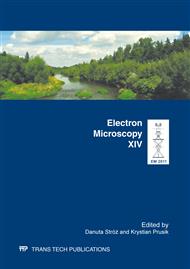p.13
p.16
p.20
p.24
p.28
p.32
p.37
p.41
p.45
A Quantitative Analytical Method for the Identification and Characterization of Mineralized Nanoparticles in Food Supplements
Abstract:
Food supplements play an increasing role in the nanofood market because improvement of effectiveness and efficiency of delivery of bioactive compounds is presumed. An electron microscopic method based on the international Standard ISO 13322-1:2004 was developed for controlling and documenting size, size distribution, surface structure, shape and aggregation state of mineralized food supplement particles. For particle size distribution, a combination of conventional TEM- and SEM-methods, which allows identifying the size distribution of the whole product, is described.
Info:
Periodical:
Pages:
28-31
Citation:
Online since:
March 2012
Authors:
Keywords:
Price:
Сopyright:
© 2012 Trans Tech Publications Ltd. All Rights Reserved
Share:
Citation:


